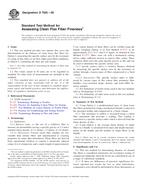Potrebujeme váš súhlas na využitie jednotlivých dát, aby sa vám okrem iného mohli ukazovať informácie týkajúce sa vašich záujmov. Súhlas udelíte kliknutím na tlačidlo „OK“.
ASTM D7025-09
Standard Test Method for Assessing Clean Flax Fiber Fineness
Automaticky preložený názov:
Štandardná testovacia metóda na hodnotenie Clean ľanové vlákna Jemnosť
NORMA vydaná dňa 1.7.2009
Informácie o norme:
Označenie normy: ASTM D7025-09
Poznámka: NEPLATNÁ
Dátum vydania normy: 1.7.2009
Kód tovaru: NS-37336
Počet strán: 5
Približná hmotnosť: 15 g (0.03 libier)
Krajina: Americká technická norma
Kategória: Technické normy ASTM
Anotácia textu normy ASTM D7025-09 :
Keywords:
fineness, flax fiber, linear density, micronaire reading, Flax fiber and products, ICS Number Code 59.080.20 (Yarns)
Doplňujúce informácie
| Significance and Use | ||||||||||
|
This test method for determining fineness of cleaned flax fibers is considered satisfactory for acceptance testing of commercial shipments when the levels are controlled by use of a range of calibration standards. If there are differences of practical significance between reported test results for two or more laboratories, comparative tests should be performed by those laboratories to determine if there is a statistical bias between them, using competent statistical assistance. As a minimum, use test samples that are as homogenous as possible, are drawn from the material from which the disparate test results were obtained, and are randomly assigned in equal numbers to each laboratory for testing. These test results from the two laboratories should be compared using a statistical test for unpaired data, at a probability level chosen prior to the testing series. If a bias is found, either its cause must be found and corrected, or future test results for that material must be adjusted in consideration of the known bias. The resistance that a plug of flax fibers offers to the flow of air is measured as an approximate indication of the average relative fineness of the fibers. The total surface area of finer fibers has a larger per unit mass and increased resistance to airflow than do coarser fibers. Instruments are available to indicate the resistance to air flow using either compressed air or a vacuum; and are constructed (1) to measure airflow under constant pressure drop across the plug, (2) to measure pressure drop when a constant flow of air is maintained, or (3) to indicate resistance to air flow from both a balanced and unbalanced Wheatstone bridge. The reliability of the results of any test method depends primarily upon how well the specimens tested represent the original source material. Flax fibers are different from many textile fibers, such as cotton or synthetic ones, in that they are not individual filaments but bundles of fibrous material that may or may not be completely separated into individual filaments and therefore have a high degree of variability. While cleaning and processing can produce separation and changes in length, there is no certainty of fibrillation of the fibrous material. Note 3—A modification of this test method can be used in commercial trading to select bales that will conform to contract guarantees for specified specific surface index. For this purpose, the usual practice to test only one specimen per sample. This specific surface index reading is related to the average linear density of single fibers in a bundle calculated from mass and length measurements on the bundle and the number of single fibers in the bundle. The specific surface index of flax fibers may be a function of fineness, degree of retting, cleanliness, variety, bundle separation, and plant maturity harvest date. This fineness of flax fibers affects their mill processing and spinning performance as well as contributes significantly to the appearance and strength of the yarns produced. The accuracy of weighing can be controlled by the number of fibers composing the bundle. However, with short fiber of low linear density the number of fibers to be counted becomes prohibitive unless the bundle mass is kept low. |
||||||||||
| 1. Scope | ||||||||||
|
1.1 This test method provides two options that cover the determination of the fineness of clean loose flax fibers by: Option 1, measuring the specific surface area by the resistance of a plug of flax fibers to air flow under prescribed conditions, or Option 2, estimating the mass per unit length. Note 1—For other methods for determining the fineness of fibers refer to Appendix X1. 1.2 The values stated in SI units are to be regarded as standard. No other units of measurement are included in this standard. 1.3 This standard does not purport to address all of the safety concerns, if any, associated with its use. It is the responsibility of the user of this standard to establish appropriate safety and health practices and determine the applicability of regulatory limitations prior to use. |
||||||||||
| 2. Referenced Documents | ||||||||||
|




 Cookies
Cookies
